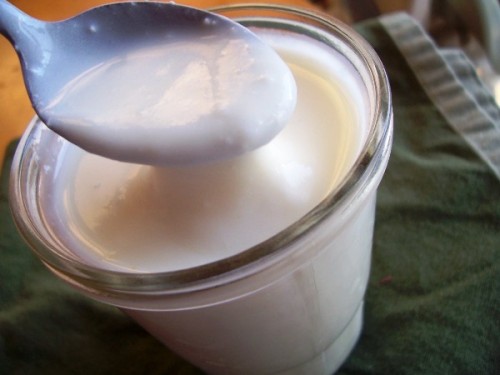Fermented Food for Beginners: Dairy

Most of us have seen or eaten cultured or fermented dairy at some point. Yogurt and sour cream are probably the most commonly consumed cultured dairy foods. Today we will look at those and others that you can make at home and incorporate into your daily diet.
First of all let’s discuss the benefits of fermenting dairy:
- It contains friendly bacteria that are necessary for health. These bacteria help stave off candida overgrowth and improve digestion.
- It is better tolerated by those who might be sensitive to milk and cream.
- It improves the nutrient profile of the milk or cream.
- It extends the shelf life of milk or cream.
So, what are these cultured dairy products, how can we make them at home and how can we introduce them into our daily diet? I’ll share with you some tips from my own limited knowledge…
Yogurt
Almost all of us have had yogurt at one time or another. In fact I was pleasantly surprised to find out that how to make yogurt in the crock pot has been one of my most popular posts. One thing that I have learned over the past few months is that you can make raw yogurt without the use of a yogurt maker. I have a few different raw yogurt cultures that I hope to play with soon, but the basic method for raw milk yogurt goes something like this:
- In order to secure consistent results you must first make a starter from the powdered culture and pasteurized milk.
- Combine said starter with raw milk and allow to culture in a warm place until thickened.
- Save the pasteurized culture for your next batch and continue making yogurt, preparing a new batch of starter when necessary.
- Chill in the refrigerator overnight for optimum consistency.
Yogurt can be eaten plain, with fruit and/or sweetener, used in smoothies, strained to make a delicious greek yogurt or yogurt cheese and used in recipes like my yogurt ranch dip.
You can find powdered starters here, which is where I procured mine.
Buttermilk
Buttermilk is something that is also familiar to most of us. It is thick and tangy and adds a lovely flavor to baked goods and ranch dressing. Unlike the buttermilk that comes from the making of real butter, the buttermilk you buy in the store is cultured. But again, you can make it at home with raw milk. The basic method for raw buttermilk goes something like this:
- Create and maintain a pure starter by using pasteurized milk and the powdered culture.
- To make buttermilk combine 3/4 cup of raw milk with 1/4 cup of the pure starter, being sure to retain 1/4 cup of the starter for your next batch of pure starter.
- Allow to culture in a warm place for 12-18 hours.
Buttermilk can be used to add great texture and tang to baked goods, added to ranch dressing or even drank straight from the cup.
You can find powdered starters here, which is where I procured mine.
Kefir
Kefir was fairly foreign and intimidating to me up until a couple of years ago. I tried making some with grains from a friend, but without any instructions I failed and so did my kefir. With detailed instructions I was aware that the first few batches may not “kefir” and so I used only a cup of milk for those and was patient enough to keep trying until by the 3rd batch we had kefir. Since then we have had at least a pint of this jewel on hand at all times for smoothies.
The basic method for raw kefir goes something like this:
- You will receive kefir grains (gelatinous cottage-cheese like lumps) along with a little bit of kefir.
- Dump both the grains and the kefir into about a cup of raw milk.
- Cover with cheesecloth or a cloth napkin secured with a rubberband.
- Leave in a warm place for 12-24 hours.
- Your first few batches may not “kefir”, thus leaving you with soured milk – which you can use for baking. Don’t be discouraged. Simply strain out the kefir grains and start another batch.
- You will know your milk has kefired when it is thick (won’t run up the sides when tilted) and smells slightly yeasty.
- Strain or fish out the grains, place them in a clean jar, start another batch of kefir and refrigerate the old one.
- I have found that when I am pressed for time or am low on raw milk I can put the finished kefir (with grains) in the refrigerator for a day or two before starting a new batch.
Our favorite way to eat kefir is in smoothies in combination with fruit. I have also read that you can drink it plain or with a little vanilla and sweetener.
You can find kefir grains here, which is where I procured mine.
Creme Fraiche or Sour Cream
If you have some extra cream sitting around you can make creme fraiche using your homemade buttermilk. I have yet to make this myself since cream is at a high premium in our home, but I hope to one day if we happen to have extra. From what I’ve read the basic method for making creme fraiche or sour cream goes something like this:
- Mix about a cup of raw cream with approximately 1 teaspoon – 1 tablespoon buttermilk.
- Allow to culture in a warm place until thickened.
- Refrigerate.
Use as a topping, a base for desserts and on everything else you can think of because it will be so yummy and nutritious.
******
So that is what I know about cultured dairy. I found out that it is much more approachable than I thought and easy to continue to maintain. I am thankful to have found help with starters and detailed instructions in order to take that leap and feed my family more yummy, healthy and frugal foods.
How about you… which fermented dairy foods have you tried? Did I miss anything that you can share with the rest of us? The next part in this series will address lacto-fermented vegetables, just in time for preserving the harvest.



I love making yogurt in my crockpot! I love your method. I used to make it on the stove and culture it in my sink. But is was such a hassle. The crockpot makes it all so easy!
I was even asked to teach a class at my church about making yogurt. I introduced them to 3 different methods. Five of them have come up to me and told me they love making yogurt in their crockpots! Thanks for the turtorial!!
I am doing a lot of fermented foods these days to help my digestive issues. I can’t do dairy, but I make coconut milk yogurt. I just started a batch of veggie kraut today.
I have found that the raw milk cultures don’t work all that well. Hope you have better luck!
What a wonderfully informative post!! Great tackle:-)
This is something that I really want to do soon!
There’s so many wonderful cultured dairy foods: kefir, yogurt, bonny clabber, blaand and other goodies. We love them!
I have trouble with raw milk yogurt not tasting so great and having lumpy texture, but I love my homemade yogurt with store milk. I have been successfully making buttermilk, but I am surprised that it doesn’t seem to last longer than a week. I thought cultured foods were supposed to have a better life than that. ?
” have found that when I am pressed for time or am low on raw milk I can put the finished kefir (with grains) in the refrigerator for a day or two before starting a new batch.”
Is that what they mean by kefiring on alternate days?
I’ve been trying to find the correct method to do this, as I’m getting sick of doing my kefir every day.
Would love to know what others do.
Cheers,
Ben.
Oooh this post is great, I’ve been really curious about making my own yogurt and haven’t been brave enough yet. Checking out your links, thanks so much!
I’d like to know too Ben, plz post if you find any answers. Thx.
I always have tons of buttermilk on hand, but not really traditional cultured. I get raw milk and usually let it sour on the counter for day before making butter, the resulting buttermilk is thick and tangy and quite delicious!
I do need to start making more yogurt, one of these day!
I’m confused about whether to use raw milk or pasteurized milk with my buttermilk or kefir starters?! The instructions included say to heat raw milk first before using in a culture or it will damaged your culture!
Do you use raw milk in your fermented dairy products?
Thanks!
Ben, I routinely kefir in a 2 qt jar every other day with no problems to the kefir end product or to the kefir grains. If I don’t have time to strain out the grains when the kefir is “done”, I just pop the whole jar in the frige and deal with it when I can. If space in the fridge is tight (like around the holidays) I’ve also been known to put the strained kefir grains into a smaller jar that has a few inches of head room, splash in enough raw milk just to cover, lightly screw a lid on it and toss THAT in the fridge for a day. So far, so good.
Re: “heating” or “scalding” raw milk for buttermilk or kefir, I never ever ever heat up my raw milk when making kefir. Heating kills off the enzymes which I think defeats the whole purpose.
As I understand it (and per the instructions I got with my buttermilk starter), when you’re making (or increasing) your starter you’re supposed to heat the milk to 160 degrees, cool it off and then add that to your existing starter. Then when the starter has clabbored, you use some of that to innoculate unheated raw milk. The purpose of heating the milk used for the starter is just to keep it “pure” so it isn’t compromised over time. Not necessary with the buttermilk you’re going to drink.
could you advise where i can get raw milk?
I buy milk from the super market, where else? Thank you
Where can I buy raw milk? It is not sold at supermarkets…Thanks
I make creme fraishe on a regular basis. Creme fraishe and sour cream taste the same and are made from the same culture but creme fraishe is made from cream and melts when heated, and sour cream is half cream and half whole milk and holds a thick consistency easier and curdles easily when heated. Creme fraishe can also be churned into cultured butter and the liquid that is poured off is called churned buttermilk and is also cultured. If this buttermilk is allowed to settle in the fridge, the whey will rise to the top and can be poured off and used to ferment vegetables.
I have had my Kefir grains for about 7 years.
I go through phases of not being interested in making or drinking the stuff (But into it right now :).
I don’t make Kefir every day. Actually it often depends on the time of year and room temp. Sometimes I just let it culture in the fridge but this slows the fermentation right down.
I know this is not recommended practice but…
I have even left my Kefir grains in milk for around 6 months in the back of the fridge!
When I want to drink kefir again I simply strain the grains, removing any scum, throw away the very old kefir liquid, and start again in a clean jar – it will take some time for the grains to wake up again (keep straining & putting in fresh milk.)
Sure my grains may not be multiplying profusely, but they still work and the kefir tastes fine.
Pretty robust cultures I recon! No need to be too particular about the process (unlike yoghurt or sourdough starters!)
Enjoy your kefir! (Love it best in a kefir banana smoothie)
I am just starting to look at fermented foods. Need all the help I can get.
I am tring to see where you got your starters from but when I click on the link it takes me to another page w/o a link for the starter. Can you please tell us what company you use.